A room-by-room checklist simplifies moving by organizing tasks per space, ensuring nothing is missed. It helps track progress, reduces stress, and streamlines packing efficiently.
Importance of Organization in Moving
Organization is key to a stress-free move, helping you stay in control and avoid last-minute chaos. A structured approach ensures efficient packing, reduces time spent searching for items, and minimizes errors. By breaking tasks into manageable steps, you can tackle each room systematically, ensuring nothing is overlooked. Proper organization also helps in tracking progress, making it easier to delegate tasks and coordinate with movers. This methodical approach not only saves time but also reduces anxiety, making the entire moving process more manageable and less overwhelming from start to finish.
Benefits of a Comprehensive Moving Plan
A detailed moving plan offers clarity and efficiency, ensuring every step is thoughtfully executed. It reduces stress by breaking tasks into manageable parts, allowing for better time management and resource allocation. With a clear roadmap, you can prioritize tasks, avoid last-minute chaos, and ensure nothing is forgotten. A well-structured plan also enhances communication with movers and helps track progress. By minimizing unpredictability, it provides peace of mind, making the transition to your new home smoother and more organized from start to finish.
How to Create a Personalized Moving Checklist
Start by assessing your specific needs and timeline. Begin with a master list, breaking tasks into categories like packing, utilities, and logistics; Declutter before listing items to avoid unnecessary moves. Categorize tasks by room and priority, ensuring nothing is overlooked. Use digital tools or printable templates for organization. Tailor the checklist to your lifestyle, including essentials like an “unpack first” box. Review and update regularly to stay on track. This personalized approach ensures a seamless and stress-free relocation experience.

Kitchen Checklist
A kitchen checklist ensures all items are packed properly. Include dishes, glassware, utensils, appliances, food, and cleaning supplies. Label boxes clearly for easy unpacking and moving day essentials.
Dishes and Glassware
Packing dishes and glassware requires careful attention to avoid breakage. Use sturdy boxes and packing paper or bubble wrap for protection. Wrap each item individually, stacking plates face down and bowls upside down. Label boxes as “Fragile” and indicate the room they belong to. Pack rarely used items first, leaving essentials like everyday dishes for later. Consider color-coding labels for easy identification. Handle fine china and crystal with extra care, placing them in separate boxes. Ensure all items are clean and dry before packing to prevent moisture damage during transit.
Cooking Utensils and Appliances
Organize cooking utensils and appliances by categorizing them into groups, such as baking tools, cooking gadgets, and small appliances. Pack utensils in sturdy boxes, using dividers or paper to prevent scratching. For appliances, wrap cords securely and include manuals. Label boxes clearly, noting contents and the room they belong to. Use bubble wrap or foam for fragile items like glassware or electronic components. Pack heavier items, like slow cookers, at the bottom of boxes. Keep essential items, like a favorite knife or coffee maker, easily accessible on moving day.
Food and Pantry Items
Sort and declutter expired or unused food items to avoid unnecessary weight. Pack non-perishables in sturdy boxes, using dividers to prevent breaking. Transfer spices and dry goods into airtight containers for freshness. Label boxes clearly with contents and “Fragile” if needed. Consider color-coding boxes by category for easy organization. Keep a separate box for essentials like snacks, coffee, or tea for moving day. Pack heavier items, like canned goods, at the bottom of boxes for stability. Ensure all items are clean and dry before packing to prevent mold or odors during transit.
Cleaning Supplies
Gather and sort cleaning supplies, discarding expired or unused items. Pack heavy-duty cleaners, mops, and brooms in sturdy boxes. Separate fragile items like glass bottles or spray cans, ensuring they are tightly sealed. Label boxes as “Cleaning Supplies” and indicate “Fragile” if needed. Store hazardous materials like bleach or ammonia separately, following safety guidelines. Keep frequently used items like sponges or dusters in an easily accessible box. Consider color-coding boxes for different rooms to streamline unpacking. Pack multipurpose cleaners and paper towels for quick access on moving day.
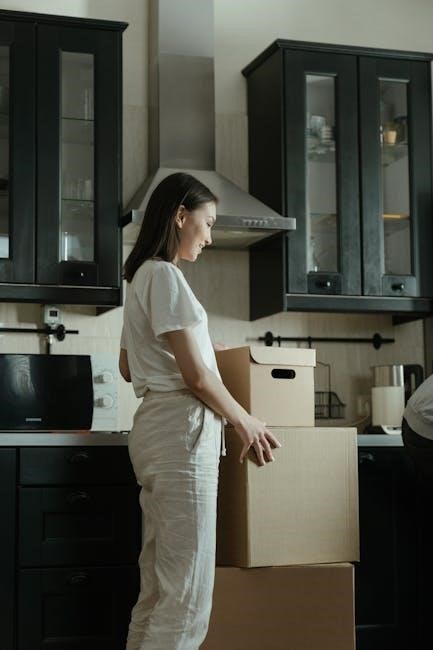
Bedroom Checklist
Organize your bedroom move by packing clothing, shoes, furniture, and bedding. Sort items, label boxes, and ensure personal items like jewelry are securely stored. Color-code for efficiency.
Clothing and Accessories
Sort and categorize clothing by season, type, and priority. Pack out-of-season items first, using sturdy boxes and breathable bags. Label boxes clearly, indicating contents and room. Use dividers or small bags for accessories like belts, hats, and scarves. Consider color-coding boxes by family member or category. Include a separate bag for essentials like underwear and a change of clothes. Donate or discard items no longer needed. Ensure delicate or special-care items are packed separately for protection.
Furniture and Bedding
Disassemble and label furniture pieces, ensuring hardware is secured in labeled bags. Protect mattresses with covers and wrap bulky items like sofas in plastic. Use furniture sliders to prevent damage during movement. Pack bedding separately, including sheets, blankets, and comforters. Label boxes clearly, indicating contents and designated room. Consider color-coding for organization. Include a list of tools needed for reassembly. Ensure fragile or special-care items are packed with extra padding. Keep track of all pieces to avoid losing hardware or components during the move.
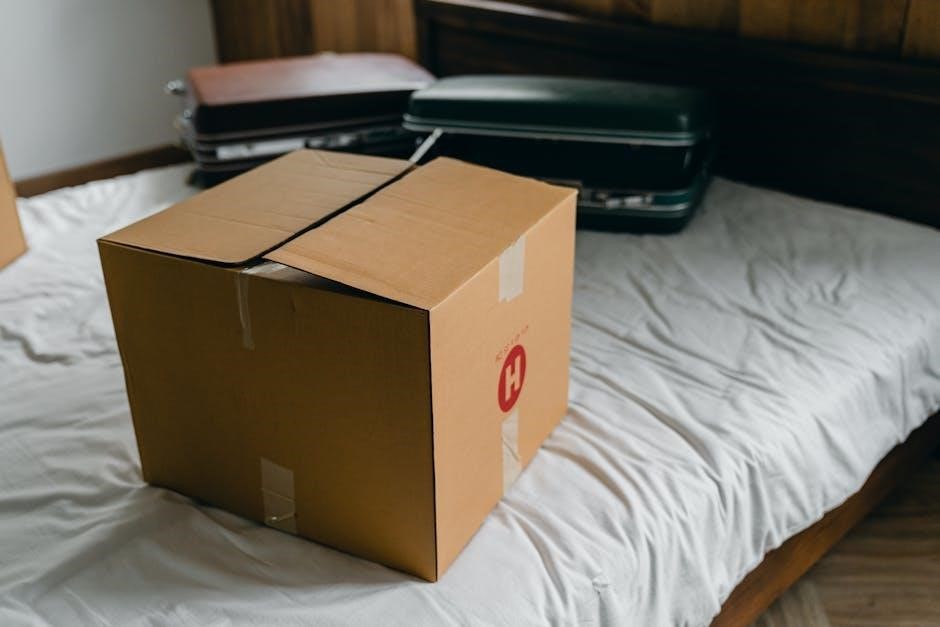
Personal Items and Jewelry
Organize personal items and jewelry carefully to ensure they remain secure during the move. Use a dedicated box or case with padding for fragile or valuable pieces. Label each item to avoid confusion and keep track of everything. Consider keeping this box with you on moving day for added safety. Create an inventory list with descriptions and photos for insurance purposes. Pack sentimental items separately and ensure all pieces are accounted for before sealing the box.
Shoes and Accessories
Pack shoes and accessories methodically to ensure they remain protected and organized. Use sturdy boxes or bags, separating items with paper to prevent damage. Label boxes clearly to identify contents easily. Organize accessories like belts, hats, and scarves in smaller containers or zippered bags. Keep frequently used items accessible for moving day. Ensure all shoes are clean and wrapped individually to maintain their condition. Double-check that no items are left behind by cross-referencing with your moving checklist.

Bathroom Checklist
Organize toiletries, towels, and medications systematically. Use waterproof containers for liquids and label boxes clearly. Ensure all personal care items are packed safely and accounted for.
Toiletries and Cosmetics
Pack toiletries and cosmetics systematically to avoid clutter. Start by gathering essentials like toothbrushes, toothpaste, shampoo, conditioner, and body wash. Use waterproof bags or containers for liquids to prevent leaks. Separate personal care items like razors, shaving cream, and makeup into labeled categories. Include a travel-sized kit with daily essentials for easy access on moving day. Don’t forget to pack feminine hygiene products, Q-tips, cotton balls, and makeup remover. Check expiration dates and dispose of expired items. Keep valuable or sensitive items, like perfume or skincare, in a separate, clearly marked box. Ensure all items are neatly organized and easily accessible after the move.
Towels and Linens
Organize towels and linens efficiently to ensure they remain clean and accessible during the move. Sort items by type, such as bath towels, hand towels, washcloths, and bed linens. Pack seasonal or less frequently used items first, storing them in labeled boxes or vacuum storage bags to save space. Use bedding to wrap fragile items for extra protection. Clearly label each box with its contents and the room it belongs in. Include a small essentials kit with a fresh set of towels and linens for moving day convenience.
Bathroom Accessories
Gather and pack bathroom accessories systematically to avoid clutter. Include items like shower curtains, bath mats, soap dispensers, and toothbrush holders. Use small, sturdy boxes to prevent damage, and wrap fragile items like mirrors or decorative pieces carefully. Label each box clearly with its contents and the room it belongs in. Consider storing these items separately from everyday toiletries to ensure easy access after the move. Pack an essentials kit with a few basics for moving day convenience, such as a spare shower curtain or bath mat.
Medications and First Aid
Organize medications and first aid supplies carefully to ensure accessibility and safety. Pack prescription medications in their original containers and keep them easily accessible. Include a first aid kit with band-aids, antiseptics, and pain relievers. Label all boxes clearly and store them in a designated area to prevent loss or damage. Consider creating a small essentials pouch for moving day, containing critical items like pain relievers, band-aids, and any urgent medications. Ensure all family members know where these items are located for quick access during the move.
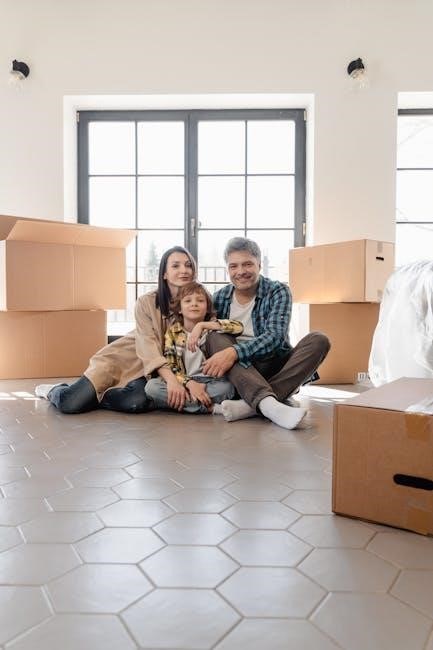
Living Room Checklist
Pack furniture, decor, electronics, books, and plants. Label boxes clearly and ensure fragile items are protected. Keep remote controls and cables organized for easy setup.
Furniture and Decor
Start by disassembling large furniture pieces and wrapping them in protective covers. Label each item clearly for easy identification. Use sturdy boxes for smaller decor items like lamps, vases, and picture frames. Pack cushions and throws separately to prevent creasing. Ensure all furniture hardware, such as screws and bolts, is stored in labeled Ziploc bags. For delicate items, add extra padding to avoid damage during transit. Keep an inventory of all decor pieces to ensure nothing is misplaced during the move. This step ensures your living room is packed efficiently and responsibly.
Electronics and Cables
Organize cables and accessories by labeling and bundling them with zip ties or cable organizers. Disconnect electronics and wrap cords securely to prevent tangling. Use protective sleeves or bubble wrap for fragile components like screens or gaming consoles. Label each cable with its corresponding device for easy setup. Pack remotes, adapters, and chargers in a designated box. Ensure all ports are covered to avoid dust or damage. Wrap sensitive electronics in soft materials to protect during transit. Keep an inventory of all items to ensure nothing is misplaced. This step ensures your electronics arrive safely and are ready for quick installation. Proper organization prevents lost or damaged items, making setup in your new space efficient and stress-free.
Books and Media
Sort books by size and genre, packing them in sturdy boxes with protective lining. Use bubble wrap for fragile covers or special editions. Organize CDs, DVDs, and vinyl records in protective sleeves or cases. Label boxes clearly for easy identification. Consider digitizing media to reduce bulk. Pack a separate box for electronics like e-readers or tablets. Keep track of cables and chargers separately. Ensure all media is clean and dry before packing. This method ensures your collection arrives intact and is ready for easy unpacking in your new space.
Plants and Accessories
Inspect plants for health and prune if necessary. Pack small pots and accessories separately, using bubble wrap for fragile items. Label boxes clearly to avoid damage. For larger plants, secure them in sturdy containers to prevent movement during transit. Include care instructions for each plant. Protect outdoor furniture and seasonal decorations with weather-resistant covers. Keep track of gardening tools and accessories in a designated box. Ensure all items are clean and dry before packing to prevent mold or damage during the move.
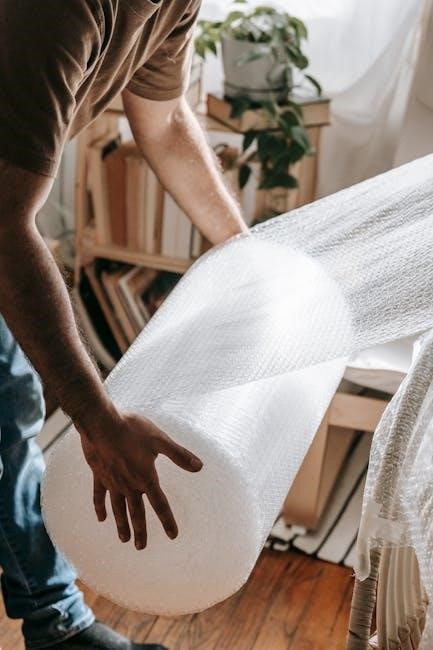
Office/Study Checklist
Organize files, pack electronics securely, and label office supplies. Ensure all documents are backed up digitally. Keep cords and cables tidy for easy unpacking later.
Documents and Papers
Start by organizing files into categories, such as financial records, personal documents, and work-related papers. Use a moving binder or digital folder to keep everything accessible. Pack essential documents separately, like identification and insurance papers, for easy access on moving day. Shred unnecessary paperwork to reduce clutter. Label boxes clearly, indicating contents and their destination. Consider digitizing important files for safekeeping and convenience. Ensure all critical documents are securely stored to avoid loss during transit.
Office Supplies
Gather and sort office supplies, such as pens, notebooks, and staplers, into categories. Pack items like paper, folders, and binders in sturdy boxes to protect them during transit. Label each box clearly with its contents and the room it belongs in. Use smaller containers for items like pushpins or clips to keep them organized. Consider grouping electronics and cables separately for easy access. Finally, review your supplies to ensure nothing is left behind or unnecessarily moved.
Electronics and Equipment

When moving, carefully disconnect and label all electronics, such as computers, printers, and routers. Use original packaging if available or purchase protective cases. Organize cables and chargers in labeled ziplock bags to avoid tangles. Assign a dedicated box for electronics to prevent damage. Keep essential devices easily accessible for immediate use. Ensure all equipment is clean and dry before packing to prevent moisture damage. Inventory each item to track during transit and verify upon arrival.
Furniture and Organizers
Disassemble furniture to make moving easier and protect pieces with bubble wrap or covers. Label all parts and hardware in clearly marked containers. Clean and inspect furniture before packing to ensure it’s ready for the move. Use felt pads on furniture legs to prevent scratching floors. Pack organizers like shelves, bins, and drawers separately, ensuring they are empty and secure. Create an inventory of furniture items to track and verify upon arrival at the new location, ensuring nothing is misplaced or damaged during transit.

Garage and Outdoor Spaces Checklist
Organize your garage and outdoor spaces by packing tools, equipment, sports gear, and seasonal decorations. Secure furniture and ensure all items are properly labeled and protected.
Tools and Equipment
When packing your garage, start with tools and equipment. Sort hand tools, power tools, and gardening equipment into categories. Use sturdy boxes and bubble wrap for fragile items like drills or saws. Label each box clearly, indicating contents and the room they belong to. Consider color-coding labels for easy identification. Keep small items like screws or nails in sealed bags to prevent loss. Make an inventory list to track all tools and ensure nothing is left behind. Proper packing ensures your tools arrive safely and remain organized for easy unpacking at your new location.
Sports and Recreational Gear
Packing sports and recreational gear requires careful planning to protect bulky and fragile items. Start by deflating balls and dismantling equipment like bikes or skis. Use sturdy boxes or bags for larger items, and wrap fragile gear in bubble wrap. Label boxes clearly with contents and “Fragile” warnings. Store smaller accessories like gloves or goggles in sealed bags to prevent loss. Consider creating a checklist to track all items, ensuring nothing is left behind. Proper organization ensures your gear arrives in great condition for your next adventure.
Seasonal Decorations
When moving, organize seasonal decorations by type and pack them securely. Use sturdy boxes for ornaments, lights, and fragile items, wrapping each in bubble wrap. Label boxes with their contents and the season they belong to. Store out-of-season items first to save space. Consider color-coding boxes by season for easy identification. Make a checklist to track each decoration, ensuring nothing is misplaced. Proper packing ensures your decorations remain intact and ready for their next use, making future holidays and events less stressful.
Outdoor Furniture and Plants
Outdoor furniture and plants require special care during a move. Disassemble furniture if possible, and clean or cover items to protect from damage. Use sturdy boxes or bags for cushions and fabrics. For plants, drain pots of excess water and pack soil separately to avoid leakage. Label boxes clearly and keep plants upright to prevent tipping. Consider transporting plants in a separate vehicle for better control. Keep an inventory of all items to ensure nothing is left behind. Proper packing ensures your outdoor items arrive in great condition for your new space.
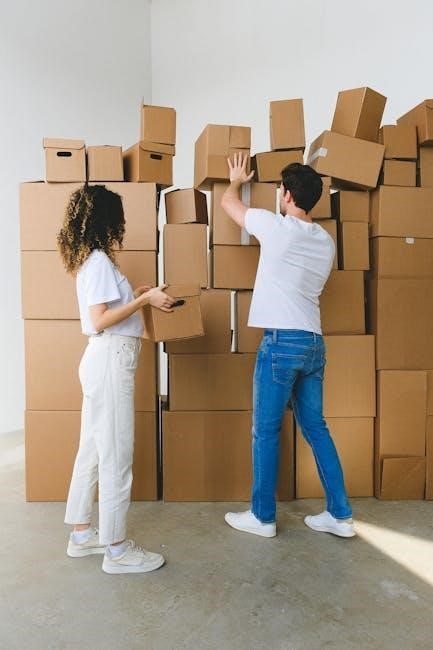
Additional Resources
Downloadable PDF checklists, customizable templates, and printable versions are available to help you organize your move efficiently. These tools ensure a smooth and stress-free relocation experience.
Downloadable PDF Checklist
A downloadable PDF checklist provides a structured and convenient way to organize your move. These checklists are often comprehensive, covering every room and item, and can be easily printed. Many PDF checklists are customizable, allowing you to tailor them to your specific needs. They include detailed lists for each room, such as kitchen essentials, bedroom items, and bathroom supplies, ensuring nothing is overlooked. With a PDF checklist, you can track your progress, stay organized, and enjoy a stress-free moving experience. Online tools also offer downloadable versions for added convenience.
Printable Versions for Easy Use
Printable versions of moving checklists offer a practical solution for organizing your move. These documents are designed to be user-friendly, allowing you to physically check off tasks as you complete them. They often include space for notes and customization, making it easy to adapt the checklist to your specific needs. Printable checklists are ideal for those who prefer a hands-on approach, ensuring you stay on track without relying on digital tools. They can be easily shared with family members or movers, promoting collaboration and efficiency during the moving process.
Customizable Templates
Customizable templates allow you to tailor your moving checklist to suit your specific needs. These templates can be edited to include or exclude sections, making them adaptable for any type of move. Whether you’re moving to an apartment or a house, customizable templates ensure that your checklist is personalized and efficient. Many templates also offer the option to add deadlines and notes, helping you stay organized and on track. This flexibility makes them ideal for both small and large moves, ensuring every detail is accounted for.
Online Tools for Tracking Progress
Online tools offer a convenient way to track your moving progress digitally. Platforms like Google Sheets or Excel allow you to create and manage checklists, set deadlines, and monitor tasks in real-time. Digital checklists with checkboxes enable you to visually track completion, ensuring no step is overlooked. These tools are accessible from any device, making it easy to update your progress on the go. They help maintain organization and accountability, ensuring a smooth and efficient move.
Final Checklist for Moving Day
Verify all items are packed, confirm moving details, and prepare an essentials kit. Conduct a final walk-through to ensure nothing is left behind.
Last-Minute Packing Tips
Double-check each room to ensure nothing is left behind. Pack essentials like toiletries and medications separately for easy access. Label boxes clearly and confirm fragile items are well-protected. Use linens or towels to cushion items instead of bubble wrap. Keep valuable documents and keys in a safe, accessible place. Defrost and clean appliances before moving. Pack a toolkit for last-minute disassembling or reassembling. Review your room-by-room checklist to ensure all items are accounted for and securely packed. Stay organized to avoid last-minute chaos.
Confirming Moving Details
Before moving day, call your moving company to confirm the time, date, and details. Verify the truck size and parking arrangements to avoid delays. Ensure all permits or parking passes are secured. Confirm the payment method and review the moving contract. Recheck the moving truck arrival time and driver contact information. Notify utilities, banks, and relevant parties of your address change. Ensure all family members are aware of the moving plan and their responsibilities. Double-check that all services are scheduled correctly to avoid last-minute issues.
Essentials Kit for Moving Day
An essentials kit is a must-have for moving day, containing items you’ll need immediate access to. Include snacks, water, medications, first aid supplies, and toiletries like toothbrushes and toilet paper. Pack a change of clothes for each family member, along with towels and bedding. Don’t forget phone chargers, flashlights, and a multi-tool. Keep important documents like keys, contracts, and ID in a safe, easily accessible place. This kit ensures you’re prepared for any situation without digging through boxes on moving day.
Final Walk-Through of the House
A final walk-through ensures your old home is left in good condition and nothing is forgotten. Check each room to confirm all belongings are packed and no items remain. Ensure all doors, windows, and cabinets are closed securely. Verify that all lights, electronics, and appliances are turned off and functioning properly. Leave keys in an agreed-upon location and double-check for any personal items. This step ensures a smooth transition and avoids last-minute issues, giving you peace of mind as you move to your new home.
A room-by-room checklist ensures a smooth, stress-free move by organizing tasks and tracking progress. It helps you stay focused, efficient, and confident throughout your relocation journey.
A room-by-room checklist is essential for a stress-free move, helping you stay organized and ensure nothing is overlooked. Start early, packing non-essential items first, and label boxes clearly. Track progress with a downloadable PDF or printable version, and customize templates to suit your needs. Prioritize decluttering and organizing, and use online tools to manage tasks efficiently. Remember to confirm moving details, prepare an essentials kit, and conduct a final walk-through. Stay focused and enjoy your new space with a well-planned relocation strategy.
Staying Organized for a Smooth Move
A room-by-room checklist ensures organization by breaking tasks into manageable steps. Label boxes clearly, track progress with a downloadable PDF, and use online tools for efficiency; Declutter early, pack non-essentials first, and keep essentials accessible. Confirm moving details and prepare a kit for moving day. Stay focused, and use customizable templates to adapt to your needs. Proper organization reduces stress and ensures a seamless transition to your new home.
Enjoying Your New Space
A well-planned move sets the stage for enjoying your new home. Once settled, take time to explore your space and make it feel personal. Unpack essentials first, arrange furniture thoughtfully, and organize belongings to create a comfortable environment. A room-by-room checklist ensures everything is in place, allowing you to focus on making memories. Celebrate the fresh start and take pride in your new space, knowing the effort you put into planning paid off for a smooth transition.

